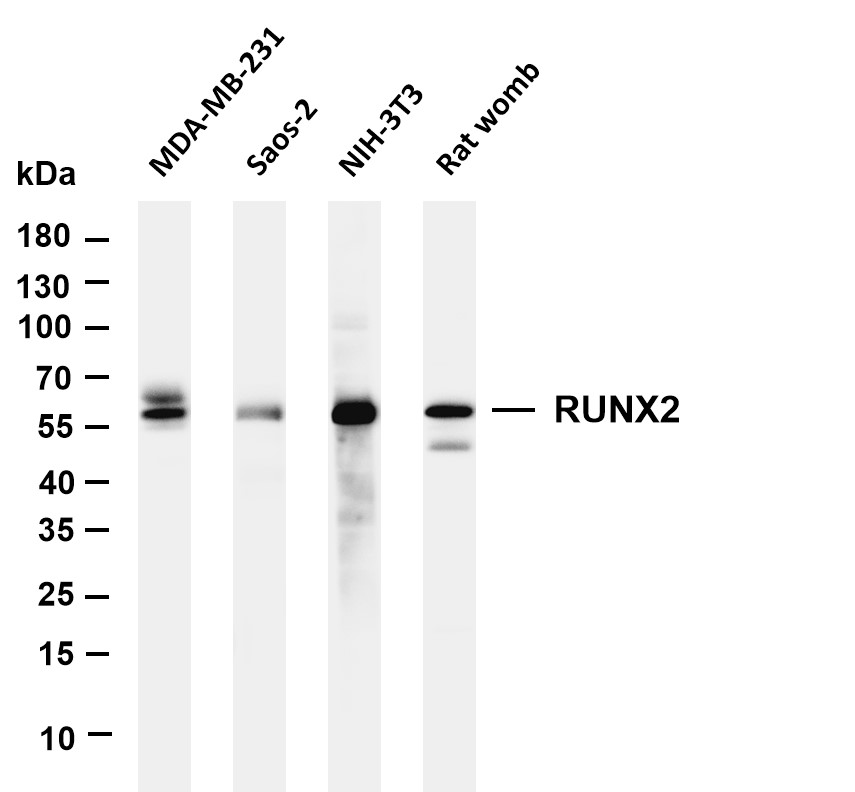RUNX2 (PT0524R) PT® Rabbit mAb
- Catalog No.:YM8347
- Applications:WB;IHC;IF;IP;ELISA
- Reactivity:Human; Mouse; Rat;
- Target:
- RUNX2
- Fields:
- >>Parathyroid hormone synthesis, secretion and action;>>Transcriptional misregulation in cancer
- Gene Name:
- RUNX2
- Protein Name:
- Runt-related transcription factor 2
- Human Gene Id:
- 860
- Human Swiss Prot No:
- Q13950
- Mouse Gene Id:
- 12393
- Mouse Swiss Prot No:
- Q08775
- Rat Swiss Prot No:
- Q9Z2J9
- Specificity:
- endogenous
- Formulation:
- PBS, 50% glycerol, 0.05% Proclin 300, 0.05%BSA
- Source:
- Monoclonal, rabbit, IgG, Kappa
- Dilution:
- IHC 1:1000-1:5000;WB 1:2000-1:10000;IF 1:200-1:1000;ELISA 1:5000-1:20000;IP 1:50-1:200;
- Purification:
- Protein A
- Storage Stability:
- -15°C to -25°C/1 year(Do not lower than -25°C)
- Other Name:
- RUNX2;AML3;CBFA1;OSF2;PEBP2A;Runt-related transcription factor 2;Acute myeloid leukemia 3 protein;Core-binding factor subunit alpha-1;CBF-alpha-1;Oncogene AML-3Osteoblast-specific transcription factor 2;OSF-2;Polyomavirus enhancer-binding protein 2 alpha A subunit;PEA2-alpha A;PEBP2-alpha A;SL3-3 enhancer factor 1 alpha A subunit;SL3/AKV core-binding factor alpha A subunit
- Molecular Weight(Da):
- 57kD
- Observed Band(KD):
- 57kD
- Background:
- This gene is a member of the RUNX family of transcription factors and encodes a nuclear protein with an Runt DNA-binding domain. This protein is essential for osteoblastic differentiation and skeletal morphogenesis and acts as a scaffold for nucleic acids and regulatory factors involved in skeletal gene expression. The protein can bind DNA both as a monomer or, with more affinity, as a subunit of a heterodimeric complex. Two regions of potential trinucleotide repeat expansions are present in the N-terminal region of the encoded protein, and these and other mutations in this gene have been associated with the bone development disorder cleidocranial dysplasia (CCD). Transcript variants that encode different protein isoforms result from the use of alternate promoters as well as alternate splicing. [provided by RefSeq, Jul 2016],
- Function:
- disease:Defects in RUNX2 are the cause of cleidocranial dysplasia (CCD) [MIM:119600]. CCD is an autosomal dominant skeletal disorder with high penetrance and variable expressivity. It is due to defective endochondral and intramembranous bone formation. Typical features include hypoplasia/aplasia of clavicles, patent fontanelles, wormian bones (additional cranial plates caused by abnormal ossification of the calvaria), supernumerary teeth, short stature, and other skeletal changes. In some cases defects in RUNX2 are exclusively associated with dental anomalies.,domain:A proline/serine/threonine rich region at the C-terminus is necessary for transcriptional activation of target genes and contains the phosphorylation sites.,function:Transcription factor involved in osteoblastic differentiation and skeletal morphogenesis. Essential for the maturation of osteoblasts and both intramembranous a
- Subcellular Location:
- Nucleus
- Expression:
- Specifically expressed in osteoblasts.
CD137-CD137L Aggravates Calcification of Vascular Smooth Muscle Cell and Vasculature of ApoE−/− Mice Via Rab7-Mediated Autophagy WB Mouse aortas/VSMC
Effect of stretch frequency on osteogenesis of periodontium during periodontal ligament distraction. Orthodontics & Craniofacial Research. Human,Dog 1:100,1:500 alveolar bone PDLSCs
Increased expression of osteopontin in subchondral bone promotes bone turnover and remodeling, and accelerates the progression of OA in a mouse model Aging-Us. 2022 Jan 15; 14(1): 253–271. WB Mouse
The osteogenic effects of porous Tantalum and Titanium alloy scaffolds with different unit cell structure. COLLOIDS AND SURFACES B-BIOINTERFACES Colloid Surface B. 2022 Feb;210:112229 WB Rat 1:2000 rat bone mesenchymal stem cells
Liraglutide regulates bone destruction and exhibits anti-inflammatory effects in periodontitis in vitro and in vivo. JOURNAL OF DENTISTRY J Dent. 2020 Mar;94:103310 WB Human hPDLCs
PTH1-34 promotes osteoblast formation through Beclin1-dependent autophagic activation. JOURNAL OF BONE AND MINERAL METABOLISM J Bone Miner Metab. 2021 Jul;39(4):572-582 WB Mouse MC3T3-E1 cell
Activation of CD137 signaling accelerates vascular calcification in vivo and vitro. INTERNATIONAL JOURNAL OF CARDIOLOGY Int J Cardiol. 2017 Mar;230:198 WB Mouse aorta
RAGE/galectin-3 yields intraplaque calcification transformation via sortilin. ACTA DIABETOLOGICA Acta Diabetol. 2019 Apr;56(4):457-472 WB Mouse 1:1000 VSMCs
Relationship between coronary artery calcification and calcium deposition in the myocardium:. JOURNAL OF INTERNATIONAL MEDICAL RESEARCH 2019 May 22 WB Human myocardial tissue
Chen, Rui, et al. "Activation of CD137 Signaling Enhances Vascular Calcification through c-Jun N-Terminal Kinase-Dependent Disruption of Autophagic Flux." Mediators of inflammation 2018 (2018).
The effect of liraglutide on the proliferation, migration, and osteogenic differentiation of human periodontal ligament cells." Journal of periodontal research (2018).
Zhang, Yue, et al. "IPO7 Promotes Odontoblastic Differentiation of Mouse Dental Papilla Cells by Selectively Importing Odontogenic Transcription Factors." (2020).
Effect of Tensile Frequency on the Osteogenic Differentiation of Periodontal Ligament Stem Cells International Journal of General Medicine Hong Qi WB Human
IPO7 promotes odontoblastic differentiation and inhibits osteoblastic differentiation through regulation of RUNX2 expression and translocation STEM CELLS Yang Guobin WB,IF Mouse
Superoxide dismutase 2 scavenges ROS to promote osteogenic differentiation of human periodontal ligament stem cells by regulating Smad3 in alveolar bone-defective rats JOURNAL OF PERIODONTOLOGY Wei Qiu WB Human human periodontal ligament stem cells (hPDLSCs)
Naringenin modulates the NO‑cGMP‑PKG signaling pathway by binding to AKT to enhance osteogenic differentiation in hPDLSCs INTERNATIONAL JOURNAL OF MOLECULAR MEDICINE Shenghong Li WB,IF Human,Rat 1:2000,1:100 periodontal ligament tissue,new bone tissue human periodontal ligament stem cell(hPDLSC)
- June 19-2018
- WESTERN IMMUNOBLOTTING PROTOCOL
- June 19-2018
- IMMUNOHISTOCHEMISTRY-PARAFFIN PROTOCOL
- June 19-2018
- IMMUNOFLUORESCENCE PROTOCOL
- September 08-2020
- FLOW-CYTOMEYRT-PROTOCOL
- May 20-2022
- Cell-Based ELISA│解您多样本WB检测之困扰
- July 13-2018
- CELL-BASED-ELISA-PROTOCOL-FOR-ACETYL-PROTEIN
- July 13-2018
- CELL-BASED-ELISA-PROTOCOL-FOR-PHOSPHO-PROTEIN
- July 13-2018
- Antibody-FAQs
- Products Images

- Various whole cell lysates were separated by 4-20% SDS-PAGE, and the membrane was blotted with anti-RUNX2 (PT0524R) antibody. The HRP-conjugated Goat anti-Rabbit IgG(H + L) antibody was used to detect the antibody. Lane 1: MDA-MB-231 Lane 2: Saos-2 Lane 3: NIH-3T3 Lane 4: Rat womb Predicted band size: 57kDa Observed band size: 57kDa



